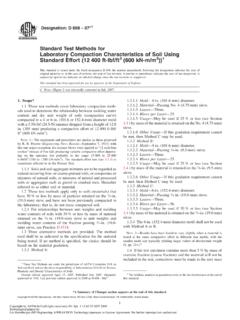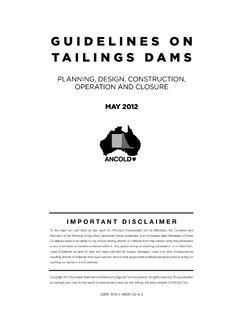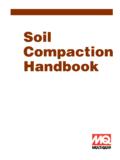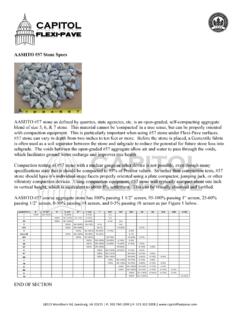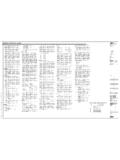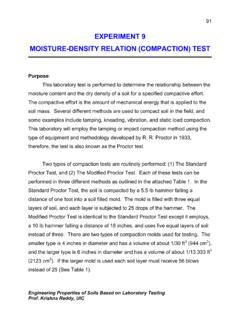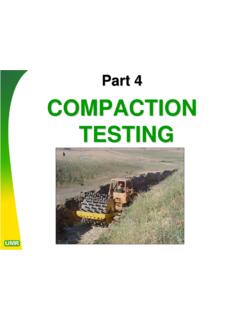Transcription of Standard Test Methods for Laboratory Compaction ...
1 Designation: D 698 07e1 Standard Test Methods forLaboratory Compaction Characteristics of Soil UsingStandard Effort (12 400 ft-lbf/ft3(600 kN-m/m3))1 This Standard is issued under the fixed designation D 698; the number immediately following the designation indicates the year oforiginal adoption or, in the case of revision, the year of last revision. A number in parentheses indicates the year of last reapproval. Asuperscript epsilon (e) indicates an editorial change since the last revision or Standard has been approved for use by agencies of the Department of Figure 2 was editorially corrected in July Scope* These test Methods cover Laboratory Compaction meth-ods used to determine the relationship between molding watercontent and dry unit weight of soils ( Compaction curve)compacted ina4or6-in.
2 ( or ) diameter moldwith a ( ) rammer dropped from a height of (305 mm) producing a compactive effort of 12 400 ft-lbf/ft3(600 kN-m/m3).NOTE1 The equipment and procedures are similar as those proposedby R. R. Proctor (Engineering News Record September 7, 1933) withthis one major exception: his rammer blows were applied as 12 inch firmstrokes instead of free fall, producing variable compactive effort depend-ing on the operator, but probably in the range 15 000 to 25 000ft-lbf/ft3(700 to 1200 kN-m/m3). The Standard effort test ( )issometimes referred to as the Proctor Soils and soil-aggregate mixtures are to be regarded asnatural occurring fine- or coarse-grained soils, or composites ormixtures of natural soils, or mixtures of natural and processedsoils or aggregates such as gravel or crushed rock.
3 Hereafterreferred to as either soil or These test Methods apply only to soils (materials) thathave 30 % or less by mass of particles retained on the3 4-in.( ) sieve and have not been previously compacted inthe Laboratory ; that is, do not reuse compacted For relationships between unit weights and moldingwater contents of soils with 30 % or less by mass of materialretained on the3 4-in. ( ) sieve to unit weights andmolding water contents of the fraction passing3 4-in. ( ) sieve, see PracticeD Three alternative Methods are provided. The methodused shall be as indicated in the specification for the materialbeing tested.
4 If no method is specified, the choice should bebased on the material 4-in. ( ) Passing No. 4 ( ) per Layer May be used if 25 % or less (see ) by mass of the material is retained on the No. 4 ( ) Usage If this gradation requirement cannotbe met, then Method C may be 4-in. ( ) Passing3 8-in. ( ) per Layer May be used if 25 % or less (see ) by mass of the material is retained on the3 8-in. ( ) Usage If this gradation requirement cannotbe met, then Method C may be 6-in. ( ) Passing3 4-in. ( ) per Layer May be used if 30 % or less (see ) by mass of the material is retained on the3 4-in.
5 ( ) The 6-in. ( ) diameter mold shall not be usedwith Method A or Results have been found to vary slightly when a material istested at the same compactive effort in different size molds, with thesmaller mold size typically yielding larger values of density/unit weight(1, pp. 21+). If the test specimen contains more than 5 % by mass ofoversize fraction (coarse fraction) and the material will not beincluded in the test, corrections must be made to the unit mass1 These Test Methods are under the jurisdiction of ASTM Committee D18 onSoil and Rock and are the direct responsibility of Subcommittee on Texture,Plasticity and Density Characteristics of edition approved April 15, 2007.
6 Published July 2007. Originallyapproved in 1942. Last previous edition approved in 2000 as D 698 boldface numbers in parentheses refer to the list of references at the end ofthis *A Summary of Changes section appears at the end of this ASTM International, 100 Barr Harbor Drive, PO Box C700, West Conshohocken, PA 19428-2959, United by ASTM Int'l (all rights reserved); Fri Apr 3 12:42:32 EDT 2009 Downloaded/printed byLiz Hershberger (M3 Engineering AFFILIATION Technology) pursuant to License Agreement. No further reproductions molding water content of the specimen or to the appropri-ate field-in-place density test specimen using PracticeD This test method will generally produce a well-definedmaximum dry unit weight for non-free draining soils.
7 If thistest method is used for free-draining soils the maximum unitweight may not be well defined, and can be less than obtainedusing Test MethodsD All observed and calculated values shall conform to theguidelines for significant digits and rounding established inPracticeD 6026, unless superseded by this For purposes of comparing measured or calculatedvalue(s) with specified limits, the measured or calculatedvalue(s) shall be rounded to the nearest decimal or significantdigits in the specified The procedures used to specify how data are collected/recorded or calculated, in this Standard are regarded as theindustry Standard .
8 In addition, they are representative of thesignificant digits that generally should be retained. The proce-dures used do not consider material variation, purpose forobtaining the data, special purpose studies, or any consider-ations for the user s objectives; and it is common practice toincrease or reduce significant digits of reported data to becommensurate with these considerations. It is beyond the scopeof this Standard to consider significant digits used in analyticalmethods for engineering The values in inch-pound units are to be regarded as thestandard.
9 The values stated in SI units are provided forinformation only, except for units of mass. The units for massare given in SI units only, g or It is common practice in the engineering profession toconcurrently use pounds to represent both a unit of mass (lbm)and a force (lbf). This implicitly combines two separatesystems of units; that is, the absolute system and the gravita-tional system. It is scientifically undesirable to combine the useof two separate sets of inch-pound units within a singlestandard. This Standard has been written using the gravitationalsystem of units when dealing with the inch-pound system.
10 Inthis system, the pound (lbf) represents a unit of force (weight).However, the use of balances or scales recording pounds ofmass (lbm) or the recording of density in lbm/ft3shall not beregarded as a nonconformance with this Standard does not purport to address all of thesafety concerns, if any, associated with its use. It is theresponsibility of the user of this Standard to establish appro-priate safety and health practices and determine the applica-bility of regulatory limitations prior to Referenced Standards:3C 127 Test Method for Density, Relative Density (SpecificGravity), and Absorption of Coarse AggregateC 136 Test Method for Sieve Analysis of Fine and CoarseAggregatesD 653 Terminology Relating to Soil, Rock, and ContainedFluidsD 854 Test Methods for Specific Gravity of Soil Solids byWater PycnometerD 2168 Test Methods for Calibration of LaboratoryMechanical-Rammer Soil CompactorsD 2216 Test Methods for Laboratory Determination of Wa-ter (Moisture)
